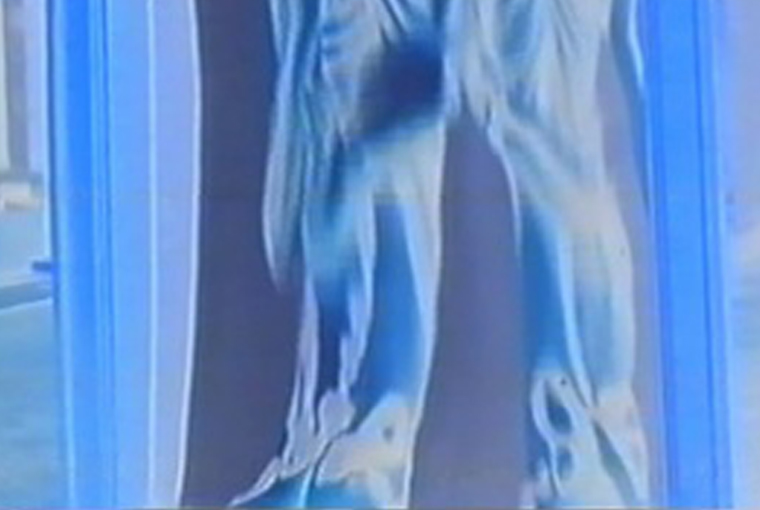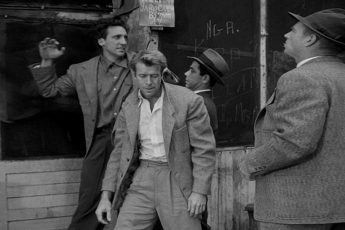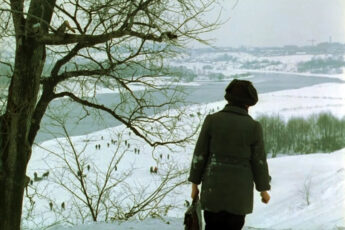Sex, Drugs and Social Criticism
Ukrainian Video Art in the 1990s and 2000s
Vol. 105 (May 2020) by Ianina Prudenko
The appeal of new artistic media — analog and digital — occurred much later in Ukraine than in countries with a long-standing capitalist system of production. This is first and foremost due to a belated access to digital technologies, an economic reality that has had demonstrable repercussions on the aesthetic nature of Ukrainian video and digital art. At the time when Western artists were free to experiment with new media, already starting to master video cameras and personal computers, the countries of the USSR, including Ukraine, remained under the dictatorship of social realism. Artists who did not fit into the system of social realism were systematically ostracized from professional artistic life: they were deprived access to the Artists’ Union of the USSR, and thus the ability to acquire basic supplies for creative production. Artists in the USSR who did not fit into the system often turned to creating art with means and materials available outside the closed professional supply networks. They used ballpoint pens, crayons, felt-tip markers and gouache; created collages from newspapers and magazine clippings; and used other rudimentary available materials for installations. Undoubtedly, these works had no official ‘right’ to be presented in society, and their creators were persecuted for producing such art or showing it to the public.1
The Party elite were a little more accommodating to experiments on the border of art and technology. In my previous studies of Soviet cybernetic art2 and audiovisual art,3 I argued that some state-of-the-art experiments could exist in a certain marginal zone. For that, they had to be useful for the government, and their creators had to avoid calling their activities art or claiming any sustainable budgets.
With the fall of the Soviet Union and the opening of the Iron Curtain, freedom of expression flowed into Ukraine, accompanied by a stream of Japanese technology. First with analog video cameras and then with digital technologies, Ukrainian artists began to address such previously taboo topics as sexuality and corporeality, drugs, and social criticism.
In the early 1990s, there were no New Media departments in art academies or art colleges in Ukraine (as remains the case to this day), so there was nothing for artists to rely on but their creative intuition. In the mid-1990s, two Soros Centers of Contemporary Art (SCCA) appeared in Ukraine: one in Kyiv and the other in Odessa. They took on the mission of educating artists to use new technologies as means of expression. The Foundation invested heavily in creating video and digital art, equipping high-tech labs to a level often superior to the most advanced design and post-production studios in Kyiv and Odessa. Subsequently, SCCA founded a new media workshop in Kyiv called InfoMediaBank. Western art connoisseurs taught there, and artists from all over Ukraine came to study. Later, SCCA founded KIMAF, Kyiv International Media Art Festival, at which Ukrainian media artists were able to showcase their research and artwork and engage with the work of leading international colleagues.
However, when the SCCA offices in Ukraine eventually closed, it became clear that the boom in media art of the second half of the 1990s and early 2000s had been an artificial phenomenon supported by a Western institution. Without high-tech labs and exhibition spaces for sophisticated technological art, Ukrainian media artists were forced to return to traditional art media or become hired workers in post-production and design studios.
The Ukrainian new media art of the 1990s and 2000s accompanied notable shifts in subject matter, not least of which was a focus on subjects of corporeality that had been taboo in Soviet society and socialist realist art. As outright artistic subjects, sexuality, psychedelic experience, and physical disability all found expression in the works of artists in the 1990s.
The nude subject and its sexuality are portrayed in a series of works by Aleksandr Gnilitsky, assembled under the name Distorting Mirrors (Kryvi Dzerkala). When the artist’s wife, Natalia Filonenko, heard from her husband that he wanted to try video as an artistic tool, she borrowed a camera from her friends at the first opportunity and turned their room in Parkomuna Squat in Kyiv into an improvised film studio. At the same time, Gnilitsky bought a set of distorting mirrors for almost nothing from the former manager of a funhouse mirror-maze. The mirrors became a way for the artist to transform reality. In 1993 he filmed two works: Distorting Mirrors – Live Pictures (Kryvi Dzerkala – Zhyvi Kartyny)4 and Dance (Tanok).5 The first work looks like a psychedelic trip with people locked up in a house, trying on their grandparents’ clothes. The distorted action takes on airs of a sacred ritual (or perhaps an orgy). The second work, Dance, was obviously intended by Gnilitsky as a working edit, since it doesn’t even have finished titles. Dance features a negative image of two skeletons dancing to the song “Venus”, by Bananarama. For this video, Gnilitsky painted black skeletons onto himself and his wife, which appear white in the negative image. In addition, the skeleton dance was filmed through a curved mirror. Alexander Solovyov, an art critic from Kyiv, points to the seemingly contradictory combination of Eros and Thanatos on display in this sexualized death-dance that typifies Ukrainian art of the early 1990s.6 In particular, he attributes this trend to the lifting of the artistic taboo on sex and drugs. The latter sometimes caused early deaths of artists.
Another dimension of corporeality that emerged as a predominant theme for artistic media artists of the 2000s was physical disability. In the USSR, the very existence of physically “imperfect” people was socially ignored.7 For example, veterans severely injured in World War II were sent away to live in extremely remote villages. Unfortunately, the situation has changed little in the post-Soviet era. People with disabilities still live in certain ghettos and move only through certain (usually very narrow and short) corridors. The needs of people with disabilities are mostly met not by government institutions but by volunteers, NGOs and artists who, in their own ways, bring the issue to public attention.
In the 2000s, numerous works were created to draw attention to the underrepresentation of people with disabilities in Ukraine. In 2000, Odessa artists Glib Katchuk and Olga Kashimbeckova created a video work entitled Anti-karaoke,8 in which one can see two blind men heartily singing the song “White Birch” (“Belaya Bereza”). In 2004, Kyiv artist Oksana Chepelyk, in collaboration with the Deaf Society, shot a video, Deaf-mute chorus (Khor glukhonimykh),9 where deaf people sing in a choir. In both Katchuk and Kashimbeckova’s and Chepelyk’s videos, artists set up situations of cognitive dissonance for their viewers. It seems obvious that blind people can’t see karaoke lyrics, and deaf people can’t sing in a choir. These videos draw the viewer’s attention to the possibilities and limitations of these outcast populations, and encourage them to question their own discomfort with such people. Continuing in this vein, Kharkiv artist Sergiy Popov created a video, Snail (Ravlyk, 2006), in which we see a man with no legs moving down the street in his own way, without any wheelchair or other assistive device. In 2007, Kyiv artists Yuriy Kruchak and Yulia Kosterieva, in collaboration with the Blind Society, created a video, Invisible Ways (Nevydymi Shliakhy), reflecting on the problematic narrowness of the corridors in which blind people walk through in Ukraine. While working with the blind, the artists found that almost all of them did not even know anything about the city district they lived in. Kruchak and Kosteryeva created a 3D model of a neighborhood and invited a blind girl to explore it by touch.
Since the 1990s, and almost to this day, another essential subject for Ukrainian media artists has been television culture. People who did not live in the USSR might find it difficult to imagine that even in the 1980s, only three channels were broadcast on Soviet TV. They offered so little content that all citizens knew the stock Soviet films, series and cartoons by heart. With the beginning of Perestroika in the second half of the 1980s, foreign (mostly South American) TV series and advertising began to penetrate the Soviet airwaves. In the early 1990s, Russian channels (which were still broadcast in Ukraine) and, later, Ukrainian channels, started to create television entertainment programs based on foreign examples. Similarly, during this period, the ads initially imported from abroad were gradually replaced by local advertisements produced by seemingly ubiquitous new studios popping up in the post-Soviet space.
It is conceivable that the US-based Soros Foundation had an economic and political interest in establishing Centers of Contemporary Art in post-Soviet countries. These countries were newly open markets, in need of professionals who would be able to create quality advertising for the products of the capitalist world. Indeed, by the late 2000s, with the withdrawal of the SCCA and the collapse of viable careers in media art, almost all Ukrainian media artists who had been brought up by the SCCA in the 1990s had shifted to careers in design and post-production studios.
With the fall of the Iron Curtain, critically-minded viewers soon realized that both Soviet and capitalist TV were using brainwashing. While the Soviet citizens had been brainwashed by broadcasts of plenary sessions of the Central Committee, the people of post-Soviet countries were being forced to buy goods they hardly needed and, most importantly, they could hardly afford. The Ukrainian art community responded to this shift by establishing their own alternative TV channels. They mostly covered contemporary art issues, hardly popular with post-Soviet Ukrainian viewers, and sometimes created absurd narrative content, all aimed at destroying the logic of traditional TV. Artists created work in the form of television programs, which had the dual use of being broadcast on TV and being displayed in exhibition spaces as video art. They include: Solid TV (1990s) by Vasyl Tsagolov (Kyiv), Situation Ute (Sytuatsia UTA, 1990s-)10 by Uta Kilter (Odessa), Untitled (1990s) by Olga Kashimbeckova and Glib Katchuk (Odesa). In the first half of the 2010s, new artists contributed to alternative TV programs. The TOTEM group (Kherson) created the Liquid TV (Zhydkoye TV)11 project, beginning in 2011. Maria Gonchar (Odessa) made the TV project We’ve Had Enough, and Now We Give it a Shot. Nam June Paik (Telebatchennia malo nas, teper my dayemo vidsich. Nam June Paik, 2013-). Alevtina Kakhidze (Kyiv) came up with the project called News of All Time (Novyny vsikh chasiv, 2015)12. However, despite a period of effective subversion of these new tools of production and exhibition, the circumstances set up by the new capitalist system did not allow for this to remain economically viable for long. This wave of post-Soviet media art was ultimately subsumed back into the television industry that had spawned it.
If the topics discussed here — sex, drugs, and social criticism — typify Ukrainian video art, they are by no means exhaustive of the trends in Ukrainian video art of the 1990-2000s. Other significant themes include a postmodern paraphrasing of the legacy of silent cinema, the use of optical illusion and glitch, and the emergence of the first feminist video art, to name a few.13
References
- 1.See: Andreeva, E. (2012). Ugol Nesootvetstvia. Shkoly nonkonformizma [Angle of inconsistency. Non-conformism schools]. Moscow: Iskusstvo XXI vek.
- 2.Prudenko, Y. (2019). Kibernetyka v gumaniternykh naukakh i iskusstvie v SSSR [Cybernetics in Humanities and Arts in the USSR]. Moscow: CCA Garazh.
- 3.Open Archive of Ukrainian Media Art. (n.d.). Retrieved from http://mediaartarchive.org.ua/lightmusic/ [Accessed on June 6th 2020].
- 4.Gnilitsky, O., Filonenko, N., & Mamsikov, M. (1993). Kryvi dzerkala — zhyvi kartyny (Distorting mirrors — Live pictures) [Video file]. Retrieved from http://www.mediaartarchive.org.ua/media-art/krivi-dzerkala-zhivi-kartini/ [Accessed on June 6th 2020].
- 5.Gnilitsky, O. & Filonenko, N. (1993). Tanok (Dance) [Video file]. Retrieved from http://www.mediaartarchive.org.ua/eng/media-art/tanok/ [Accessed on June 6th 2020].
- 6.Соловьев А. К царству Галлюцинации и Удовольствия // Финансовая Украина. – 20 апреля. – 1994. – С.22 (Solovyov A. Towards the Kingdom of Hallucination and Pleasure / Financial Ukraine. April 20, 1994. P.22).
- 7.Paparnyi, V. (2016). Kultura Dva [Culture Two]. Moscow: NLO.
- 8.Katchuk, G. & Kashimbeckova, O. (2001). Anti-karaoke [Video file]. Retrieved from http://www.mediaartarchive.org.ua/eng/media-art/antikaraoke/ [Accessed on June 6th 2020].
- 9.Chepelyk, O. (2004). Khor glukhonimykh (Deaf-mute chorus) [Video file]. Retrieved from http://www.mediaartarchive.org.ua/eng/media-art/khorglukhonimikh/ [Accessed on June 6th 2020].
- 10.Kilter, U. (2016). Au revoir Sit.U [Video file]. Retrieved from https://www.youtube.com/watch?v=B-bIZ-9Y2BE&list=PLKCs1weYcRN6tpV3zoiN7HEtMHZykDyug [Accessed on June 6th 2020].
- 11.[Totem]. (2011). Zhydkoye TV (Liquid television) [Video files]. Retrieved from https://vimeo.com/21384751, https://vimeo.com/21385165, https://vimeo.com/99475760 [Accessed on June 6th 2020].
- 12.Moscow Biennale (2015). Proizvodstvo Novostey (Production of News). Blog of the 6th Biennal of Moscow. Retrieved from https://syg.ma/@moscowbiennale/proizvodstvo-novostiei [Accessed on June 6th 2020].
- 13.See more details on Ukrainian media art: Open Archive of Ukrainian Media Art. (n.d.). Retrieved from http://mediaartarchive.org.ua/eng [Accessed on June 6th 2020].




Leave a Comment